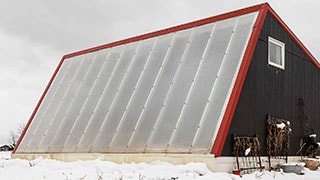Agriculture, Rural Living September 01, 2023
Age in Place
.
How can you change your home to be senior-friendly?
Baby boomers in Canada and the United States are aging. The youngest are in their 60s and the oldest are on the cusp of 80. The Canadian Association of Retired People (CARP) surveyed their 330,000 members and found that between 85 and 90 percent of them would prefer to age in place and continue living in their own homes. Bill Vangorder, CARP's Chief Operating Officer, says it's entirely possible if you are prepared for the uncertainties of life to ensure it happens. Otherwise a fall, or a health event, can quickly turn a home that meets your needs one day into one that's completely unsuitable the next and force you to move.
Often, it's just one small thing wrong with the house that forces a person to consider moving to a nursing home. It could be something as minor as your home's doors are too narrow for a wheelchair. Whatever the specific problem is, any renovations that are needed to keep the home suitable for people as they lose strength, mobility, or mental acuity as they age can't be completed overnight. That's why it's so important to have any renovations needed to keep your home age-friendly completed well in advance of when they might be needed.
"Look at where you are now in terms of your health and where you might be in five years," Vangorder says. "Then decide what needs to be done to cover all the bases. Start by looking at your home's accessibility. Take the front steps for example. How would you get into your house if you can no longer climb steps? Well, a ramp might be the answer, but often, you'll need a longer one than most would think would be necessary just by looking at the front of the house."
All the details that need to be considered can be overwhelming. Vangorder recommends hiring a physiotherapist or an occupational therapist to evaluate your home. They're professionally trained on how to design ways to make your living quarters appropriate to your needs as you age and your health declines.
Claude Dupont from Ste-Therese, Quebec decided to be proactive when he was diagnosed with an autoimmune disease that will eventually sap his strength and mobility. He needed a new place to live, so Dupont set his sights on a new condo building under construction in the area. He worked with an occupational therapist to create a living space that allowed him to remain autonomous for as long as possible.
For Dupont, this included the installation of a walk-in shower, grab bars, automatic doors and a wheelchair accessible bathroom vanity, and an adapted kitchen. Even though he didn't require them when he purchased his condo, he decided to spend a bit more to have them installed during the initial construction phase instead of paying a lot more to retrofit it.
"The condo units were sold with 32-inch doors, but I had them put in 36-inch doors to make it easier for a wheelchair," he adds. "I'm still able to walk but I believe in planning ahead."
Above. Installing backing to install support bars in the bathrooms is a simple, inexpensive addition when a house is being built, but it's a big project if they need to be added in a retrofit. Bill Vangorder with CARP says their surveys have found that between 85 to 90 percent of their members want to age in place in their own home.
Five areas. How can you plan for something that's out of your control? Vangorder says there are five areas where changes can be made to make a home more age-friendly. Install toilet seat risers, grab bars in and around tubs and showers, or renovate to curb-free shower stalls or a walk-in tub in the bathroom. Stairlifts can be installed to provide access to upper or lower floors while ramps allow for easier entry and exit from a home. Facilities like the laundry can often be moved to the main floor for easier access.
It's straight forward to install motion-activated light switches so seniors don't have to try and find one in a darkened room. Light switches can be lowered, and electrical outlets can be raised to provide easier access from a wheelchair.
Changing appliances can make the kitchen more age-friendly too. For example, choose ovens or cooking surface models that have knobs at the front to avoid the need to reach across the cooking elements. Consider fridges and dishwashers that use drawers rather than doors. Drawer inserts for cabinets can also be helpful.
You also must ensure doorways and hallways are wide enough for a wheelchair user. Slippery flooring can be replaced with non-slip products and eliminate rugs that are tripping hazards.
"Mount St. Vincent University in Halifax, Nova Scotia, did a study several years ago that found you could do all these renovations, not including a stair lift, for between $5,000 and $8,000," Vangorder says. "But if they're installed when you first build the house, they all could be done for between $800 and $1,000."
That's why CARP is encouraging the Canadian Home Builders Association to include these features in all new home construction, Vangorder says. After all, a senior-friendly home is friendly to everybody. †
Read More

AGRICULTURE, FARM OPERATION
Keep the Vegetables Coming
A deep winter greenhouse provides good winter growing conditions.

AGRICULTURE, AG TECH
Smoke and Substance
Breakthroughs promise answers to wine taint questions.




